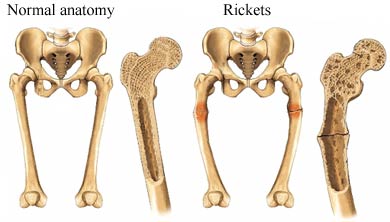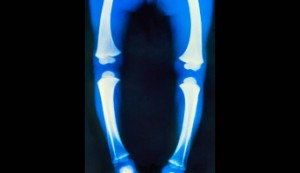The other day I was walking on the streets and noticed a person who walked by me in a posture that was crooked and had their leg extended out in an angle. My first guess was that the person was suffering from Celebral Palsy since I have met a few people in my life who had a abnormal gait pattern from having Cerebral Palsy. The way that this person was walking made me wonder just what other types of disorders and conditions might cause a person to walk in a slanted way causing their posture to be non-erect.
 I thought back to the disorders I had learned when I was doing research on Vitamin D deficiency which can lead to rickets, a disorder which causes the limbs to develop abnormally leading to bones that are often curved inwards which lead to the other name for the condition, bow legs for toddlers and knock knees in young kids.
I thought back to the disorders I had learned when I was doing research on Vitamin D deficiency which can lead to rickets, a disorder which causes the limbs to develop abnormally leading to bones that are often curved inwards which lead to the other name for the condition, bow legs for toddlers and knock knees in young kids.
I am assuming that the curved nature of, say the femur, would mean that the bones are not completely straighten out, and than means that the skeletal structure is not as straight it should be resulting in lost height of upwards of even 4-5 inches.
I have not done any research on the condition of rickets except read what is written in Wikipedia. The Mayo Clinic website does not seem to help much either since the article on rickets is very short. It seems that rickets actually makes the bones softer and weaker in children that are still developing. The vitamin known as Vitamin D has the function of absorbing the elements of calcium and phosphorous from the gastrointestinal tract. The disorder however states that even if a child is afflicted with rickets, it might be reversed and the curvature of the bone is removed if the child can get enough vitamin D into their diet.
From the website by the National Institute Of Health (NIH) on the pathology/disorder known as rickets, it states that the absorption of calcium and phosphate minerals from the bone inorganic (and organic) matrix by the blood is caused by a drop in calcium and phosphorous levels in the blood. Since the blood is essentially the transportation system of the huma body transporting vital glucose, sugars, proteins, water, and minerals from one area of the body to the other, it is more physiological vital that the homeostasis of the blood is kept in balance as compared to the bone. This means that if the blood is missing certain minerals, it will take it from the bones.
It seems that Vitamin D is obtained either from food and produced by the skin which get sunlight. The people who get rickets are often the people to stay indoors too much, work indoors, or live in climates which don’t get a lot of sunlight. As for diet, the dietary causes for the development of rickets seem to be from being either lactose intolerant, being vegetarian, and not drinking enough milk or milk derived products (like cheese yogurt). From the NIH website it also suggest that supposeddly babies who are fed only breastmilk are most likely to get rickets since the milk from the mother does not have enough Vitamin D. Dark skinned babies have a higher chance of developing rickets.
Overall, the incidence of this disease is rare in developed nations since milk and vegetables both have enough Vitamin D. There is also a type of genetic disorder that leads kids to develop rickets since it causes the Liver from not being able to convert Vitamin D into its active form.
So if a kid was suffering from bow legs, would they end up shorter than if they were not?
I suspect that it would be the case. Due to how at least the leg bones align together, vertically, a misalignment or curvature of any of the long bones would cause the the distance between the hip joint epiphysis and the distal end of the tibia to be decreased. The effect on the overall height would be decreased subsequently.
So the obvious question asked then by a concerned parent would be “would straightening and correcting bow legs (or knock knees) lead to a height increase?”
It would but not as much as some people might think. For most children who suffer from rickets, the curvature that results is not as serious as some may think it is. While some people might get an image of a kid who has their legs splayed out like a spider, the actual more likely result is a noticeable curvature in the knees, at least for people in the developed countries.
When the curvature is fixed through a better diet with the necessary amount of Vitamin D, the curvature is supposed to go away since it seems that there is some type of feedback loop mechanism between the growth plates and the length of the bones. From studies I have read, if one leg is longer than another, the growth plates of the shorter leg actually sort of go through an elevated level of longitudinal growth to compensate for the difference, through a phenomena known as “catch-up growth”. Inversely, if surgeons tried to stretch out one growth plate of a limb to make it grow thicker and faster than normal, it triggers a mechanism in the other growth plates of the same limb to grow at a much slower rate, to compensate for the difference that were externally induced.
 The amount of increase in height ultimate is usually just up to 1 inch for the least severe types of knock knees and bow legs. 2 inches of height increase from any type of bow leg correction means that there was a more severe level of deformity. 3-4 inch of increase in height from bow leg correction usually implies that the legs had even more serious curvature and problems.
The amount of increase in height ultimate is usually just up to 1 inch for the least severe types of knock knees and bow legs. 2 inches of height increase from any type of bow leg correction means that there was a more severe level of deformity. 3-4 inch of increase in height from bow leg correction usually implies that the legs had even more serious curvature and problems.
Of course I am assuming that what we are talking about is a surgical method of bow leg correction, where certain surgical method of osteotomy or bone bridging is created to align the sides of the bone to be at even level. When I am talking about bow leg or knock knee correction, I am referring to children with open growth plates which have their growth surgically manipulated to have even growth on both sides of the long bones in their lower limbs.
Let’s also remember that because the child does not have enough vitamin D, the amount of osteogenic material or deposition at the bottom of the growth plate would be much less. Remember that endochondral ossification, the actual process in which bones get longer and get formed longitudinally is the result of a cartilage AND bone tissue process. The bone tissue process is where new bones is formed where cartilage used to be. If there is not enough Vitamin D, there might be a lot of calcium in the blood that is waiting to be absorbed, but they can’t get carried by the Vitamin to the ossification region, then the bone area would not get longer, since there is no mineral building block available in the diaphyseal region to be used for the additional bone volume formation.
Plus, even if the growth plate has the highest number of of chondrocytes and have good proliferation rates and hypertrophy to be big, if there is no calcium being transported to the calcification region, the cartilage would not turn into bone tissue, and due to the loading on the cartilage, it can’t get longer so the long bones stay the same length which is just stunted growth.

Hi, I’ve got a quick question for you. Is there anything a pregnant woman should do in order to try and prevent her child from having bow legs? Actually – I know all babies/young kids do, but I mean in terms of them growing up? Thanks for your post.